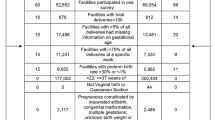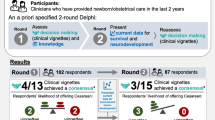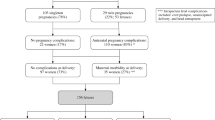Abstract
Objective:
Late-preterm (LPT) neonates account for over 70% of all preterm births in the US. Approximately 60% of LPT births are the result of non-spontaneous deliveries. The optimal timing of delivery for many obstetric conditions at LPT gestations is unclear, likely resulting in obstetric practice variation. The purpose of this study is to identify variation in the obstetrical management of LPT pregnancies.
Study Design:
We surveyed obstetrical providers in North Carolina identified from North Carolina Medical Board and North Carolina Obstetrical and Gynecological Society membership lists. Participants answered demographic questions and six multiple-choice vignettes on management of LPT pregnancies.
Result:
We obtained 215/859 (29%) completed surveys which are as follows: 167 (78%) from obstetrics/gynecology, 27 (13%) from maternal–fetal medicine, and 21 (10%) from family medicine physicians. Overall, we found more agreement on respondents’ management of chorioamnionitis (97% would proceed with delivery), mild pre-eclampsia (84% would delay delivery/expectantly manage) and fetal growth restriction (FGR) (80% would delay delivery/expectantly manage). We found less agreement on the management of severe preeclampsia (71% would proceed with delivery), premature preterm rupture of membranes (69% would proceed with delivery) and placenta previa (67% would delay delivery/expectantly manage). Management of LPT pregnancies complicated by preterm premature rupture of membranes, FGR and placenta previa vary by specialty.
Conclusion:
Obstetrical providers report practice variation in the management of LPT pregnancies. Variation might be influenced by provider specialty. The absence of widespread agreement on best practice might be a source of modifiable LPT birth.
This is a preview of subscription content, access via your institution
Access options
Subscribe to this journal
Receive 12 print issues and online access
$259.00 per year
only $21.58 per issue
Buy this article
- Purchase on Springer Link
- Instant access to full article PDF
Prices may be subject to local taxes which are calculated during checkout




Similar content being viewed by others
References
Hamilton BE, Martin JA, Ventura SJ . Births Preliminary Data for 2009 In: National Vital Statistics Reports. National Center for Health Statistics: Hyattsville, MD, 2010.
Laughon SK, Reddy UM, Sun L, Zhang J . Precursors for late preterm birth in singleton gestations. Obstet Gynecol 2010; 116 (5): 1047–1055.
Raju TN, Higgins RD, Stark AR, Leveno KJ . Optimizing care and outcome for late-preterm (near-term) infants: a summary of the workshop sponsored by the National Institute of Child Health and Human Development. Pediatrics 2006; 118 (3): 1207–1214.
Morse SB, Zheng H, Tang Y, Roth J . Early school-age outcomes of late preterm infants. Pediatrics 2009; 123 (4): e622–e629.
Petrini JR, Dias T, McCormick MC, Massolo ML, Green NS, Escobar GJ . Increased risk of adverse neurological development for late preterm infants. J Pediatr 2009; 154 (2): 169–176.
Chyi LJ, Lee HC, Hintz SR, Gould JB, Sutcliffe TL . School outcomes of late preterm infants: special needs and challenges for infants born at 32 to 36 weeks gestation. J Pediatr 2008; 153 (1): 25–31.
Teune MJ, Bakhuizen S, Bannerman CG, Opmeer BC, van Kaam AH, van Wassenaer AG et al. A systematic review of severe morbidity in infants born late preterm. Am J Obstet Gynecol 2011; 205 (4): 374:e1–374:e9.
Martin JA, Hamilton BE, Sutton PD, Ventura SJ, Mathews TJ, Kirmeyer S et al. Births: final data for 2007. Natl Vital Stat Rep 2010; 58 (24): 1–85.
Davidoff MJ, Dias T, Damus K, Russell R, Bettegowda VR, Dolan S et al. Changes in the gestational age distribution among U.S. singleton births: impact on rates of late preterm birth, 1992 to 2002. Semin Perinatol 2006; 30 (1): 8–15.
MacDorman MF, Declercq E, Zhang J . Obstetrical intervention and the singleton preterm birth rate in the United States from 1991-2006. Am J Public Health 2010; 100 (11): 2241–2247.
Fuchs K, Gyamfi C . The influence of obstetric practices on late prematurity. Clin Perinatol 2008; 35 (2): 343–360 vi.
Holland MG, Refuerzo JS, Ramin SM, Saade GR, Blackwell SC . Late preterm birth: how often is it avoidable? Am J Obstet Gynecol 2009; 201 (4): 404 e401–404 e404.
Lubow JM, How HY, Habli M, Maxwell R, Sibai BM . Indications for delivery and short-term neonatal outcomes in late preterm as compared with term births. Am J Obstet Gynecol 2009; 200 (5): e30–e33.
Carreno CA, Costantine MM, Holland MG, Ramin SA, Saade GR, Blackwell SC . Approximately one-third of medically indicated late preterm births are complicated by fetal growth restriction. Am J Obstet Gynecol 2011; 204 (3): 263 e261–263 e264.
Ananth CV, Vintzileos AM . Maternal-fetal conditions necessitating a medical intervention resulting in preterm birth. Am J Obstet Gynecol 2006; 195 (6): 1557–1563.
McIntire DD, Leveno KJ . Neonatal mortality and morbidity rates in late preterm births compared with births at term. Obstet Gynecol 2008; 111 (1): 35–41.
Behrman RE, Butler AS (eds). Preterm Birth: Causes, Consequences, and Prevention. Institute of Medicine of the National Academies Press: Washington, DC, 2006.
Brook RH, Lohr KN . Efficacy, effectiveness, variations, and quality. Boundary-crossing research. Med Care 1985; 23 (5): 710–722.
Wennberg J, Gittelsohn A . Variations in medical care among small areas. Sci Am 1982; 246 (4): 120–134.
Reddy UM, Ko CW, Raju TN, Willinger M . Delivery indications at late-preterm gestations and infant mortality rates in the United States. Pediatrics 2009; 124 (1): 234–240.
Oshiro BT, Henry E, Wilson J, Branch DW, Varner MW . Decreasing elective deliveries before 39 weeks of gestation in an integrated health care system. Obstet Gynecol 2009; 113 (4): 804–811.
Donovan EF, Lannon C, Bailit J, Rose B, Iams JD, Byczkowski T . A statewide initiative to reduce inappropriate scheduled births at 36(0/7)-38(6/7) weeks' gestation. Am J Obstet Gynecol 202 (3): 243 e241–243 e248.
Fisch JM, English D, Pedaline S, Brooks K, Simhan HN . Labor induction process improvement: a patient quality-of-care initiative. Obstet Gynecol 2009; 113 (4): 797–803.
Lockwood CJ, Lemons JA (eds). Guidelines for Perinatal Care. 6th edn. American Academy of Pediatrics and The American College of Obstetricians and Gynecologists 2007.
Spong CY, Mercer BM, D'Alton M, Kilpatrick S, Blackwell S, Saade G . Timing of indicated late-preterm and early-term birth. Obstet Gynecol 2011; 118 (2 Pt 1): 323–333.
Buchanan SL, Crowther CA, Levett KM, Middleton P, Morris J . Planned early birth versus expectant management for women with preterm prelabour rupture of membranes prior to 37 weeks' gestation for improving pregnancy outcome. Cochrane Database Syst Rev 2010; 17 3: CD004735.
Oyelese Y, Smulian JC . Placenta previa, placenta accreta, and vasa previa. Obstet Gynecol 2006; 107 (4): 927–941.
Peabody JW, Luck J, Glassman P, Dresselhaus TR, Lee M . Comparison of vignettes, standardized patients, and chart abstraction: a prospective validation study of 3 methods for measuring quality. J Am Med Association 2000; 283 (13): 1715–1722.
Veloski J, Tai S, Evans AS, Nash DB . Clinical vignette-based surveys: a tool for assessing physician practice variation. Am J Med Qual 2005; 20 (3): 151–157.
Peabody JW, Luck J, Glassman P, Jain S, Hansen J, Spell M et al. Measuring the quality of physician practice by using clinical vignettes: a prospective validation study. Ann Intern Med 2004; 141 (10): 771–780.
Acknowledgements
This project described was supported by the National Center for Research Resources, Grant UL1RR025747, and is now at the National Center for Advancing Translational Sciences, Grant UL1TR000083. We would like to thank the North Carolina Health Professions Data System, Cecil G Sheps Center for Health Services at UNC, North Carolina Medical Board, North Carolina Obstetrical and Gynecological Society and North Carolina Section, American Congress of Obstetrics and Gynecology for their contribution to study recruitment.
Author information
Authors and Affiliations
Corresponding author
Ethics declarations
Competing interests
The authors declare no conflict of interest.
Additional information
Disclaimer
The content is solely the responsibility of the authors and does not necessarily represent the official views of the National Center for Research Resources or the National Institutes of Health.
Supplementary Information accompanies the paper on the Journal of Perinatology website
Supplementary information
Rights and permissions
About this article
Cite this article
Aliaga, S., Price, W., McCaffrey, M. et al. Practice variation in late-preterm deliveries: a physician survey. J Perinatol 33, 347–351 (2013). https://doi.org/10.1038/jp.2012.119
Received:
Revised:
Accepted:
Published:
Issue Date:
DOI: https://doi.org/10.1038/jp.2012.119



